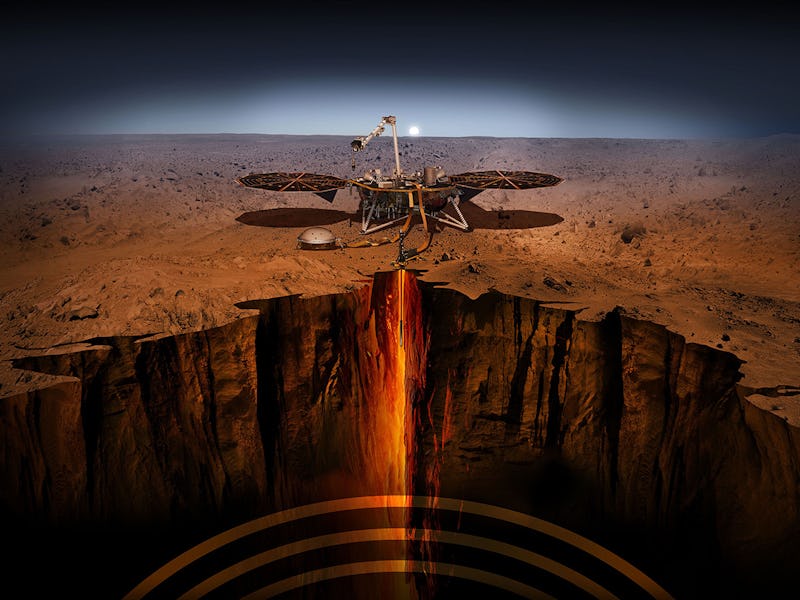NASA's ailing Mars lander captures the biggest Marsquake yet
While Insight may soon go offline, Mars decided to give it at least one last show.

The winds of Mars’ dusty season piled Martian regolith onto InSight’s solar panels. The rumble of the wind against the small, egg-shaped shield that protects the mission’s delicate seismometer drowned out the low-magnitude tremors usually felt on Mars. In the midst of this, NASA scientists thought the InSight probe might have detected its last marsquake before the mission comes to an end.
Then, on May 4, InSight’s 1,222nd day on Mars, the lander detected a magnitude 5.0 marsquake, far and away the most powerful quake ever detected off Earth. As Mark Panning, InSight’s project scientist, tells Inverse, “We were approaching a time when the dust storm was possibly going to end our mission, and we weren’t seeing small events anymore, so it was possible we weren’t going to see any more events, and then Mars decided to show off and give us a great big event that was so big it didn’t matter how noisy Mars is.”
The seismograph of the recent marsquake.
WHAT’S NEW — While the Apollo missions left a set of seismometers on the Moon that operated until 1977, InSight is the first Martian mission to carry seismic equipment. Before the probe arrived in 2018, knowledge of Mars’ interior was “very coarse,” according to Panning, based on mapping the planet’s gravity, with “large error bars on every estimate.” As Mars is smaller than Earth, its interior has cooled more, and has no evidence to date of plate tectonics; researchers were expecting the Red Planet to be comparatively tranquil.
According to Anna Horleston, a seismologist at the University of Bristol and co-lead of the Marsquake Service’s frontline team, they expected to see a kind of seismic activity on Mars like the activity found in the middle of Earth’s continental plates known as intraplate seismicity that is driven by the cooling of rocks deep within the planet.
Before August of last year, the only marsquakes the probe had detected in its first two years were small by Earth standards, below magnitude 3.7 — a level that you might experience as a light vibration within five miles of the epicenter. In August and September, the probe detected a pair of magnitude 4.2 and 4.1 quakes — which, since quake magnitude is measured logarithmically, were three times bigger than any previously measured quake.
At magnitude 5.0, the latest marsquake was over six times stronger than anything ever seen on another planet, and released almost 16 times more energy. Panning and Horleston both note that this is about the most powerful marsquake that the InSight expected the lander to detect throughout its mission.
The interior structure of Mars
WHY IT MATTERS — Although InSight’s seismometer, the Seismic Experiment for Interior Structure (or SEIS), is shielded from turbulence by its wind and thermal shield, the surface of Mars is a noisy place. Specifically, the planet’s dust storms rattle the shield, while sudden winds can cause ground-level pressure changes that shake the probe itself. All this noise makes it difficult to separate data about how seismic energy bounces off Mars’ core and crust.
In addition, Horleston [notes], while Earth is spiderwebbed with thousands of carefully sheltered seismic stations, there is only one seismometer on the entirety of Mars, which makes distinguishing signal from noise even more challenging. The team has had to develop analysis tools specifically to separate signals from weaker tectonic events from those of storms passing overhead.
But this event was far stronger and clearer than any previous event. “It’s a beautiful seismic record,” Panning says, “and we’re going to get lots of science done with it.” Having a much bigger event will make it much easier to confirm and improve the team's methods to separate seismic data from the ambient noise of Mars’ atmosphere.
Panning says this will, in turn, make it possible to go back and find smaller signals in InSight’s first 1200 days of seismic recording.
WHAT’S NEXT— The same dust storms that make it difficult for InSight’s seismometers to detect smaller marsquakes are bringing other difficulties for the lander. InSight went into safe mode shortly after it recorded the quake. The accumulation of dust on the panels combined with decreased solar energy reaching the surface means that the InSight team is now planning for a reduced amount of time using the SEIS instrument in the future.
Panning notes that while the exact timing is determined by Mars, the accumulation of dust will soon hit a point where it does not have enough energy to run its scientific instruments — unless something happens to blow the dust off the panels, which the earlier rovers Spirit and Opportunity were lucky enough to have happen.
At that time, the lander will enter an extremely-low power mode. But the team will continue to be listening for it to communicate as it waits for the solar panels to clear.
But just as—as Panning says—InSight was about to “move off into the Martian sunset,” the planet gave it an energetic sendoff.